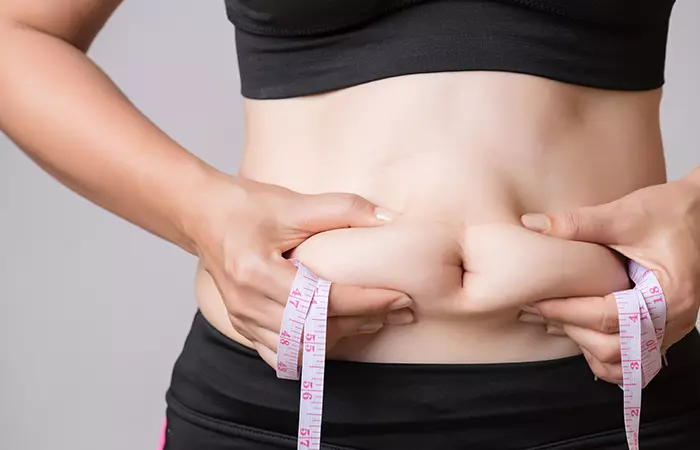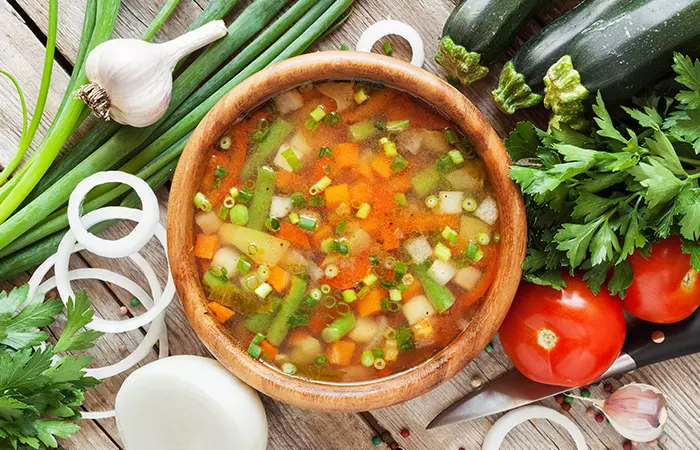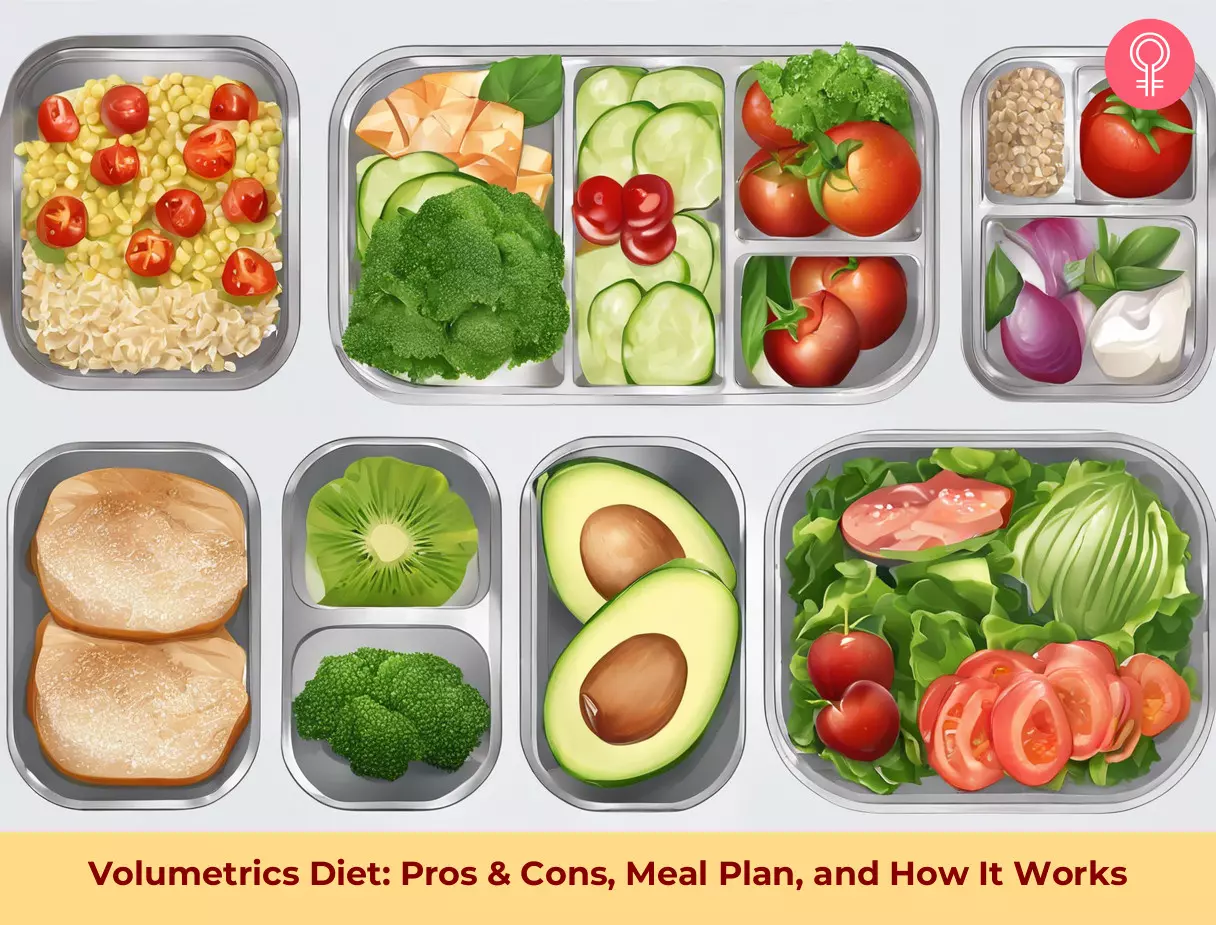What Is The Volumetrics Diet?
The volumetrics diet was developed by Barbara Rolls, a nutrition researcher and professor at Penn State University. It is based on the idea that you can regulate your calorie intake by consuming low-energy-density foods that make you feel full and less hungry.
How Does The Volumetrics Diet Work?
The volumetrics diet primarily focuses on foods with low energy density (those that contain few calories for every gram). It includes fruits, vegetables, and low calorie soups with broth as the base. These are high volume meals with a higher water content than high-energy-density foods. Consuming low-density meals will make you feel fuller and reduce your calorie intake (1). The volumetrics diet is divided into four categories of foods:
Very Low-Density Foods
These have a meager number of calories per gram and include broth-based soups and salads. These foods can be consumed in large amounts to help with satiety without adding many calories.
Low-Density Foods
These filling foods have a low number of calories per gram and include fruits, vegetables, and whole grains. These foods are the main focus of the volumetrics diet and must be consumed in larger amounts.
Medium-Density Foods
These have a moderate number of calories per gram and include nuts, seeds, and avocados. These foods can be consumed in moderate amounts.
High-Density Foods
These have a high number of calories per gram and include butter, cheese, and oils. These foods should be consumed in small amounts or avoided. The volumetrics diet promotes regular exercise as a component of a healthy lifestyle. Exercise can assist in boosting metabolism, encouraging weight loss, and enhancing general health (2). Additionally, it supports moderation food intake, which might aid in calorie restriction. The use of smaller plates, attention to hunger and fullness cues, and a mindful eating strategy can all help you achieve healthy eating.
Can The Volumetrics Diet Promote Weight Loss?
Low-energy foods are high in fiber, water, and other nutrients that can promote both weight management and overall health. A study in 2020 conducted on 3877 participants revealed that the intake of viscous dietary fiber can aid weight loss. A mean body weight reduction of 0.33 kgs to 0.14 kg was observed. The effect was greater in obese participants and in participants with diabetes. The accuracy of the evidence was evaluated to be moderate for body weight, high for waist circumference and body fat, and low for BMI. Several studies have shown that individuals who follow a low-energy-dense diet tend to lose weight and maintain weight loss over time. They also tend to have a lower body mass indexi A health assessment method that calculates the height-to-weight ratio to determine how much body fat you possess. (BMI) and body fat percentage (3), (4), (5). A study on overweight women focused on dietary energy density and came up with a method for controlling appetite and maintaining weight. The secret is to reduce energy-dense and fatty foods by increasing your consumption of fruits and vegetables (6). A study on teenagers demonstrated that a low-energy-density diet between 3.9 and 5.1 kJ/g did not cause weight gain, but an energy density of 8.64 kJ/g to 9.17 kJ/g did (7). Another study on overweight and obese women found that low energy meals had a positive impact on people trying to effectively reduce weight (8). The volumetrics diet focuses on the quality of the food and its calorie density and helps one reduce their overall calorie intake, potentially leading to weight loss. Since it is not a restrictive diet, it is more likely to be sustainable in the long run. Keep in mind that losing weight is not an easy process and may take some time before you see visible results. Every diet has its advantages and disadvantages. Discover the pros and cons of the volumetrics diet in the section below.
Pros And Cons Of The Volumetrics Diet
There are several pros and cons to the volumetrics diet:
How To Start The Volumetrics Diet
Here are some steps to help you start the volumetrics diet:
May Improve Overall Health
The volumetrics diet encourages the consumption of nutrient-dense fruits and vegetables, lean protein, and whole grains. These foods provide essential vitamins and minerals, which can improve one’s nutrient intake and general well-being (9).
May Reduce The Risk Of Chronic Diseases
The nutrient-dense foods can help reduce the risk of heart disease, diabetes, and certain types of cancer. Intake of high-energy-density foods is associated with risks of type 2 diabetesi A chronic disorder where your body does not produce enough insulin, causing elevated blood sugar levels. and pancreatic cancer (10). A few dietary adjustments that are recommended in this diet will help you reduce these risks. Low energy-density diets also help control blood sugar levels and reduce high cholesterol levels (11).
May Be Expensive
Eating vegetables, fruits, and lean protein can be more expensive than a diet high in processed foods. Energy-dense meals are the least expensive and the most inflation-resistant. This might be the underlying reason populations with inadequate financial resources continue to have the highest prevalence of obesity (12).
May Not Work For Everyone
This diet may not work for everyone and some people may not see the desired results. It is not a quick weight loss solution and requires a long-term commitment and a lifestyle change. You must make active efforts and remain consistent for the diet to work. If these cons do not stop you from taking up the challenge, scroll down for additional tips on how to get started on this diet.
- Learn About The Diet Familiarize yourself with what foods to eat and avoid on this diet. Think carefully about your lifestyle and whether it is suitable. Being aware that the diet may not be effective for you and is not recommended for everyone can spare you unpleasant situations if the diet doesn’t work.
- Make A Grocery List Make a shopping list of high-volume, low-calorie foods like fruits, whole grains, vegetables, lean meats, and low-fat dairy products. Keep in mind that this could be expensive. Choose grass-fed, organic, or wild-caught items. Processed foods are often high in calories and low in volume, so avoid them as much as you can.
- Plan Your Meals Plan ahead to ensure you have enough food choices and a balance of macros and micronutrients. If you lead a hectic life, do the majority of your meal preparation over the weekends. Make a note of any appealing, healthy dishes that caught your eye, and then try them. Being creative with the limited number of items you can eat is the secret to keeping a balanced diet. Be aware of the portion size of your meals and snacks. While high-volume foods might make you feel satisfied, moderation is key.
- Drink Plenty Of Water Drinking water can help you feel satiated and content. It is also a zero-calorie drink. Other options include lemon water or coconut water, which are equally hydrating and nourishing.
- Get Moving Regular physical activity is integral to any weight-loss diet. Aim for anywhere between 30 minutes to 1 hour each day. If you live a busy life, look for at-home exercises that can motivate you. Avoid overexercising as it might leave you feeling extremely tired.
- Keep Track Of Your Progress Monitor your weight, body composition, and general well-being regularly. You can either download fitness-tracking apps or maintain a dedicated workout journal. Also, try joining a community where you can share your progress with everyone. Having a diet/workout buddy can help you have accountability and motivation to follow through with the diet.
Volumetrics Diet Meal Plan
Here is a sample 7-day volumetrics meal plan that you can follow: Day 1 Day 2 Day 3 Day 4 Day 5 Day 6 Day 7 Before beginning any new diet plan, you should speak with a registered dietitian or any healthcare provider.
Volumetrics Diet Recipes
1. Vegetable Soup
Ingredients
1 tablespoon of olive oil 1 onion, diced 2 cloves of garlic, minced 2 carrots, peeled and diced 2 celery stalks, diced 1 cup of diced potatoes 1 cup of diced sweet potatoes 2 cups of sliced mushrooms 2 cups of chopped kale or spinach 2 cups of vegetable broth 2 cups of water 1 can of diced tomatoes 1 teaspoon of dried thyme Pepper and salt
Instructions
Heat olive oil in a large pot over medium heat. Add onion and garlic and sauté until they become translucent. Add carrots and celery and sauté for another 5 mins. Add potatoes, sweet potatoes, mushrooms, kale or spinach, vegetable broth, water, diced tomatoes, thyme, salt, and pepper. Bring the soup to a boil, reduce to low heat, and let it simmer for 20-25 minutes or until the vegetables are tender. Taste and adjust the seasoning and serve the soup hot with whole wheat bread.
2. Baked Salmon With Quinoa And Vegetable Pilaf
Ingredients For the salmon:
4 (6 oz) salmon filets 2 tablespoons of olive oil Salt and pepper to taste 1 tablespoon of lemon juice 1 tablespoon of chopped fresh herbs (parsley, dill, or basil)
For the quinoa and vegetable pilaf:
1 cup of quinoa, rinsed 2 cups of water or vegetable broth 1 tablespoon of olive oil 1 onion, diced 1 red bell pepper, diced 1 cup of sliced mushrooms 2 cloves of garlic, minced 1 teaspoon of ground cumin Pepper and salt 1/4 cup of chopped fresh parsley
Instructions
Preheat the oven to 425°F (220°C). Mix olive oil, lemon juice, herbs, salt, and pepper in a small bowl. Place the salmon filets in a baking dish. Brush the salmon with the olive oil mixture. Bake the salmon for 12-15 minutes or until the salmon is cooked through. In a medium saucepan, bring the quinoa and water or vegetable broth to a boil. Lower the heat, cover, and simmer for 18-20 minutes or until the quinoa is tender. Next, heat olive oil in a skillet over medium heat. Add onion, red bell pepper, mushrooms, and garlic and sauté for about 5 minutes or until the vegetables are tender. Stir in cumin, salt, pepper, and sauté for an additional minute. Stir in the cooked quinoa and fresh parsley. Serve the salmon on top of the quinoa and vegetable pilaf.
The volumetrics diet is a generally healthy and balanced diet that can be beneficial for many people but may not be suitable for everyone. It is possible that people with specific medical issues or dietary limitations can’t adhere to it. Learn more in the next section.
Who Should Not Follow The Volumetrics Diet Plan
The following people are advised not to follow the volumetrics diet without consulting a health care provider or a certified dietician. The diet may not be tailored enough to meet their specific nutritional needs or may exacerbate their conditions or allergies. These include:
Those who are pregnant or breastfeeding (13) Those with food allergies or sensitivities Those with celiac diseasei A condition characterized by an immune response to consuming gluten, a protein that causes inflammation and impairs nutrient absorption. (14) Those with chronic kidney diseasei A progressive kidney disorder where the organ’s ability to remove waste from the body is reduced over time, leading to its failure. (15) Those with diabetes or prediabetes (16)
Always talk to a health care provider or a registered dietitian before adopting any new diet, especially if you have any pre-existing medical condition or dietary restrictions. Is the volumetrics diet healthy? Yes, since the diet focuses on consuming nutritious foods and limiting the intake of processed foods. It is also a non-restrictive diet, which means you can eat a variety of foods and ensure you are getting all the nutrients your body needs. Fresh foods may also reduce inflammation, which can help you lose weight even if you are not cutting calories. What is the percentage of fat in the volumetrics diet plan? The volumetrics diet plan does not specify the exact percentage of fat to be included in it. However, it does recommend minimizing the consumption of saturated fati Dietary fat that raises the levels of bad cholesterol in the body, increasing the risk of heart disease and other related issues. and promotes the intake of low-fat dairy products. Can the Volumetrics Diet be combined with other eating plans or diets? The volumetrics diet can be combined with other eating plans if it aligns with your personal dietary and health needs. You can incorporate a volumetrics diet in your existing dieting plan by simply choosing low-carb, high-fiber foods and limiting your intake of high-calorie and low-nutrient food items.
Illustration: Volumetrics Diet: Pros & Cons Meal Plan and How It Works
Learn how to lose weight by following the Volumetrics Diet! Watch this video to find out how to feel satisfied by eating healthy, low-calorie foods in your diet.












